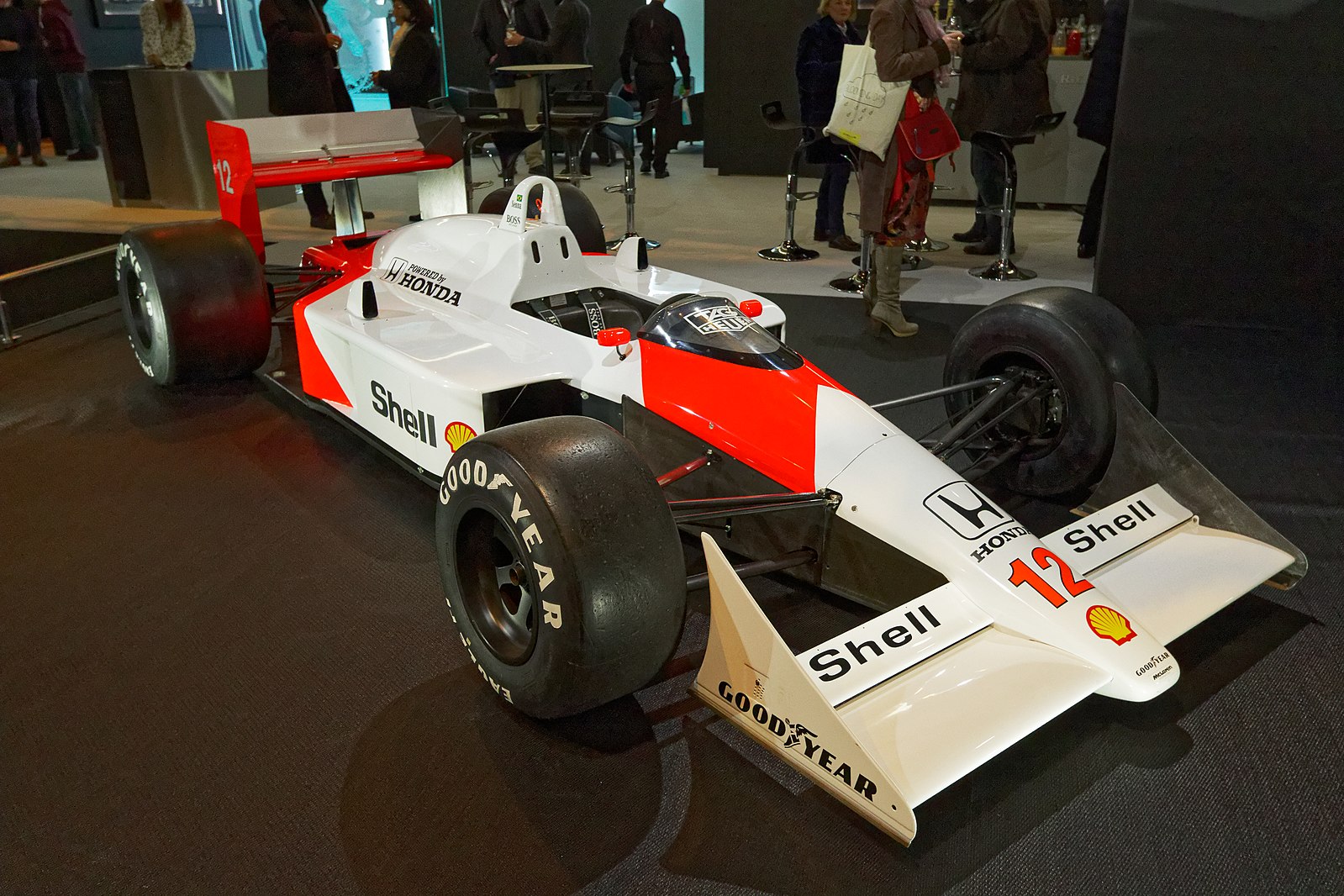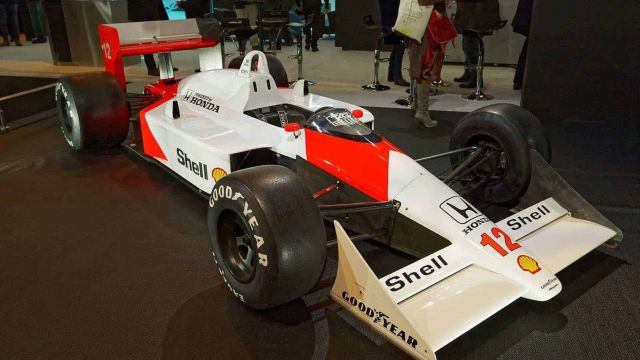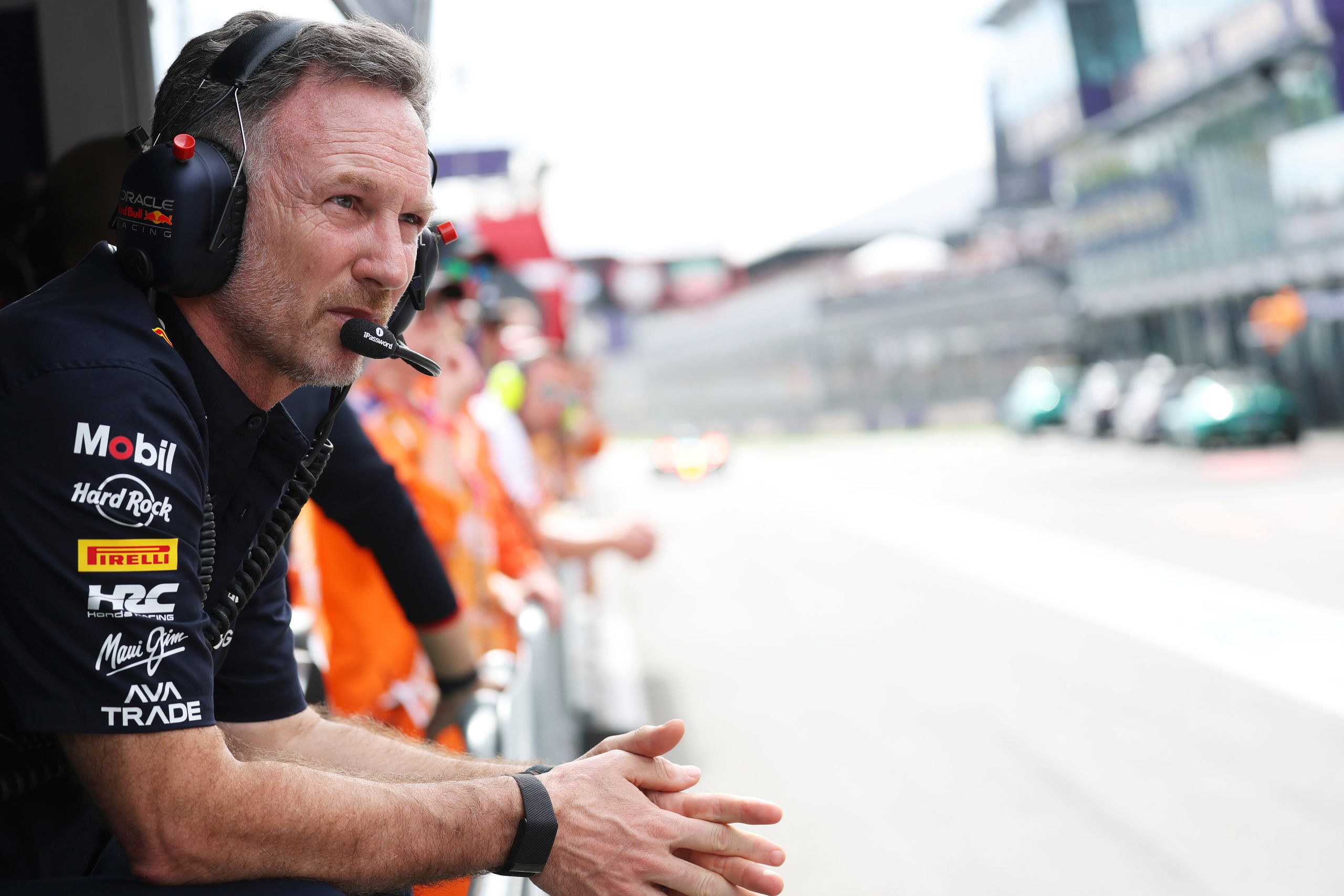The McLaren MP4/4: F1’s Most Dominant Car


The McLaren MP4/4 dominated the 1988 FORMULA 1 season, winning a staggering 15 out of 16 races, claiming 15 pole positions, and leading 1003 out of the 1078 laps raced that season.
Teammates Ayrton Senna and Alain Prost drove the car successfully through the 1988 Formula One season, but the vehicle was designed by Steve Nichols, an American auto engineer who was tasked with its design by team boss Ron Dennis. In a memo put out by technical director Gordon Murray this information was validated, and individual assignments for those in the design department regarding the vehicle were delegated in the memo as well. At that time Mr. Nichols was put in the role of chief designer, and in turn took on the role of acting liaison between those in production and the drawing department.
The RA 168E 1.5-litre engine was a V6 turbo manufactured by Honda; it produced 650hp @ 12,500rpm, and even reached 700hp on occasion. Inspired by the 1986 Brabham BT55, Murray made this the foundation for the MP4/4 design, while staying true to McLaren principles and philosophies. Some of these came from the ’87 MP4/3, but the team were able to spend more time on the design. The MP4/4 would have a smaller engine and a smaller fuel tank than the Brabham, for example.
The resulting vehicle ended up being one of the most powerful cars ever designed and built for Formula One. With the exception of the 1988 Italian Grand Prix it claimed victory in every race, and in 1988 it also managed to claim every pole position but one. From a statistical perspective, it has proven itself the most dominant car for an entire single season, with a percentage of wins that stands at 93.8%. Only one other car has come anywhere near this: The Mercedes F1 W07 Hybrid, with 19 wins out of 21 in 2016.
This video gives you an up close and personal look inside the cockpit of the McLaren MP4/4.
Mclaren MP4/4 History and Lineage
The McLaren MP4/3-TAG designed by Steve Nichols won three races with Prost behind the wheel. His win in Portugal, the third of three in 1987, was the 28th of his career. This broke 27-time winner Jackie Stewart’s previous record. The same car managed to come in second in the Constructors’ Championship, which was enough to convince Ayrton Senna to join for 1988, and even get Honda to enter into an engine supply deal for the next season, replacing the Porsche engine that was providing power for it at the time.
By the time 1988 rolled around McLaren had successfully roped in the Honda deal tightly; being considered the best engine in Formula One since 1985 made them very desirable to McLaren. With Ron Dennis heading the race team trying to get Honda for his Formula 2 team he was able to welcome Honda’s alliance with open arms. Turbo engines were being banned in 1989, and most teams were focusing on the shift to cars with natural aspiration.
Regardless of this fact, designer Nichols made a decision to move forward with the turbo design, which could have been a disadvantage for the team because regulations were in place that favoured teams who were using naturally aspirated engines.
Over the course of the race, the MP4/4 would show a lack of power when compared to competing vehicles with natural aspiration. Naturally aspirated cars had an unlimited fuel tank allowance, but turbo vehicles only got an allowance of 150 litres according to new regulations, so the MP4/4 team would have to do their utmost to conserve fuel if they wanted to make it to the end of the race successfully, and this could prove difficult, to say the least.
That same year there was rumors floating around that Honda would be releasing their V10 engine. At the Italian Grand Prix Ron Dennis had made it fairly clear that the team would not be using the V10 that year, and they had never been planning to. It was decided that they would keep the V6 for the remainder of 1988, which would give them more time to wrap things up properly with the car they were going to use in ’89, which just happened to be an improved version of the MP4/4.
Since they had the TAG-V6 to use, which had a smaller fuel tank that held only 195 litres instead of 220, McLaren was able to prove that the concept was functional and effective. It did have redesigned side pods and kept the MP4/2C nose one, which was lower and a bit smaller, but the better aerodynamics aided Stefan Johansson and Prost in closing the distance between them and Honda cars with more power than the basic MP4/2. The TAG engines were proving themselves undependable at times due to being redesigned to meet the lower fuel regulations and the turbo-restrictive pop-off valve that had been the cause of so much controversy. The team was able to use these factors to their advantage; with the smaller engine and a gas tank reduced to 150 liters in size, the McLaren MP4/4 was born in 1988. It was all-new, and one of the few that year of all competing cars that was; most others were only updated versions of previously used cars.
Mclaren MP4/4 Performance
Ayrton Senna joined McLaren on a three-year contract where he would partner with Alain Prost, and things only got better from there. Now there was the car, the drivers, and that Honda 650hp engine, a trio made in heaven.
The fuel tank restrictions laid down by the FIA for turbo-powered cars were the main concern.
Honda set its focus on the fuel consumption of the engine, the RA 168-E; it was specially built with less turbo boost (4.0 bar to 2.5 bar), done instead of an upgrade on the old ’87 engine; this way late-race retirements could be dodged altogether.
Except for a handful of aerodynamic changes, the MP4/4 performed exactly as it was throughout the entire season. It had gone through a minimal amount of testing when it arrived at Brazil for the first race, but Senna successfully put the vehicle on pole position, while Prost went on to win the opening race of the 1988 season.
Hear the McLaren MP4/4 start up in the McLaren factory.
From the Driver’s Seat
One specific feature of the MP4/4 was the way the seating positioned the driver.
The vehicle was low-slung when it came to aerodynamics, and the FIA had very specific rules in place regarding seat height and driver positioning: the top of the driver’s head had to sit between roll bar and cowling.
This had the McLaren duo in a reclining position while other drivers performed while sitting upright. Ayrton Senna claimed the car was easy to drive while in that position; Prost, on the other hand, was of smaller stature and preferred to be a bit more upright while driving.
The team was able to make necessary adjustments for Prost without making any changes to the design.
1988 safety regulations set down by the FIA also stated that the driver’s feet could not extend past a certain point around the front axle. Fortunately, cars that had been built around former regulations could be grandfathered in.
Enjoying Success
In 1988 McLaren’s MP4/4 was victorious in 15 out of 16 races, ten of which were 1-2 finishes. Prost completed 14 of the races in either 1st or 2nd place, with two retirements in Italy and Britain. In 15 out of 16 races the car took pole position, with Senna having a record-breaking 13 poles.
The team enjoyed 12 races where the front row was locked out, and had ten of the fastest race laps.
The only time the winning streak was broken was in Monza at the 1988 Italian Grand Prix in Round 12. With only two laps remaining, Senna tried to lap Jean-Louis Schlesser and was hit by the Williams driver who had made an error, and tried to return to the track; since Prost was already out due to a failed engine, that race was lost for the team, while Ferrari were able to win on home soil.
The second race of the 1988 season was held in San Marino, Italy, and that’s where the MP4/4 managed to show off its power the most. Prost and Senna both were able to qualify at the Imola circuit with 1.27s…no other cars were able to get anything better than 1.30s.
The reigning world champ, Nelson Piquet, was racing as well, and his Lotus 100T was running with a Honda engine too. Piquet qualified at 1.30s, more than 3.5 seconds slower than Senna.
The MP4/4 had a level of downforce and an ability to increase speed that was unparalleled, and many attributed this to the aerodynamic design. This also contributed to higher fuel efficiency, which was quite a feat considering the circuit.
The Imola circuit consists of the car being put through extended periods of hard acceleration, and this can be horrible when it comes to gas mileage, and this particularly applied to cars with a turbo. Being able to qualify in the time they did speaks to the excellence of the aerodynamics of the MP4/4.
As for retirements, the MP4/4 retired a total of four times the entire season. During the British Grand Prix Prost retired at Silverstone, and at the Italian Grand Prix it was retired at Monza (this was due to engine trouble, and it turned out to be the only time one of the McLarens had any engine issues all season). There were also Senna’s crashes at Monaco and Monza.
During this particular season both McLaren cars qualified for a race more than a full second faster than the competitors; this happened a total of six times. These were at Australia, San Marino, Japan, Monaco, Portugal and Germany.
A total of fifteen pole positions were won by the team, with two going to Prost and thirteen to Senna. McLaren would have had a perfect pole record if not for Gerhard Berger’s stunning lap at Silverstone.
The McLaren MP4/4 Top Speed Record
It happened during qualifying at Hockenheim in Germany: The MP4/4s driven by Prost and Senna both set the fastest speed-trap time of 1988. A speed of 207 mph (333km/h) was achieved by both drivers on the 1.6 kilometre straight.
Berger, who drove a Ferrari, reached 204 mph, and the fastest car in the non-turbo lineup, the March-Judd driven by Ivan Cappelli, reached 194 mph. With this in mind it is important to note that the 207-mph reached was still a full 12 mph slower than their fastest speed in 1987, and 11 mph slower than in 1986, both of which were reached at Monza by Nelson Piquet and Gerhard Berger, respectively.
McLaren MP4/4: More Facts and Information
The McLaren MP4/4 went through some changes at Silverstone, at least as far as aerodynamics were concerned. ‘Snorkels’ were a design feature that resulted in the feeding of air to the turbo system; they could be found on the side pods, on the very top.
At Silverstone, the snorkels were done away with, and on the very first day of qualifying the team ran into direct issues.
Both Senna and Prost reported feeling that the cars were imbalanced, so for the remainder of the British Grand Prix the snorkels were reinstated. That turned out to be the last time snorkels would be seen by anyone for the remainder of the season.
Testing was conducted further in Germany to find out why this sense of imbalance was reported, and it turned out that the suspension on the MP4/4s was set incorrectly…it had absolutely nothing to do with the snorkels!
Ron Dennis later gave an estimate that having research and development carried out on the MP4/4 for the snorkels and imbalance actually cost the team more than $205,000; for something that was unneeded, it sure turned out to improve the aerodynamics on the McLarens.
As mentioned above, the MP4/4s went through four retirements, and in Portugal and Spain the MP4/4 driven by Senna seemed to be struggling with issues regarding the readout for fuel consumption.
These problems led Senna to use less power, which obviously forced him to run the car slower, resulting in loss of time because he needed to be sure to have sufficient fuel to finish the races at hand. The good news, however, is that Alain Prost won both of those races for the team anyway.
By the end of the 1988 FORMULA 1 season, Team McLaren-Honda had won both the Drivers’ and the Constructors’ titles (Senna got the edge over Prost due to more victories, and only eleven of the best scores were counted. Prost had managed to score more points overall, but Senna took eight first-place victories, and Prost took only seven).
McLaren-Honda took a 1-2 finish in Belgium (Round 11 of sixteen races, and the eight 1-2 finish for the season). Prost and Senna would gain two more 1-2 victories, one in Australia and the other in Japan. McLaren-Honda wound up finishing the season with a whopping 134 points more than the 2nd place Ferrari that came in behind it.
What Came After The McLaren MP4/4?
The iconic MP4/4 would be succeeded in 1989 by the McLaren MP4/5, which was powered by the Honda V10 mentioned earlier. Statistically speaking, the newer McLaren was not as successful as its parent car, which is attributed by many as being due to the improvement of competing vehicles like Ferrari, Williams, and Benetton; it is also said that McLaren and Honda had slipped a bit.
The new car, however, would earn another Constructors’ Championship for the team, and Senna and Prost would earn a 1-2 finish in the Drivers’ Championship that year.
The MP4/5 was the first car to take advantage of the Pete Weismann-designed transverse transaxle.
Initially, the McLaren design team resisted Weismann’s transverse technology, so the first three-shaft longitudinal transaxle was designed by Pete Weismann to allow Gordon Murray to design the MP4/4 as low as possible. Honda’s tiny 1.5 litre V6 turbocharged engine complemented the package beautifully, and the success of the longitudinal in 1988 freed the team to design the transverse option for 1989 and the MP4/5.
Initially, the MP4/5A used the longitudinal. Then the MP4/5B was introduced mid-season with the transverse. The MP4/5 won the World Championship, winning 14 out of 16 races. Since then, transverse transmissions have become the norm in the F1 pitlane.
Lewis Hamilton, a former driver for McLaren Formula One, ended up appearing on the television competition series ‘Top Gear’, where he drove the incredible MP4/4. When Hamilton had finished driving the car, he told the program’s host, Jeremy Clarkson, the following:
“I love this car; it’s one of the best days of my life. I finally can check off my dream of driving this car.”
It should come as no surprise, however, that after the drive he also made note that the car seemed to lack grip when he compared it to the MP4-25 he had gotten to race earlier that year, which was far better aerodynamically.
You can watch Lewis Hamilton drive the McLaren MP4/4 on Top Gear here:
The MP4/4B, which was a modified version of the McLaren MP4/4, was used as something of a guinea pig by Honda for the testing of its 3.5-liter V10, which was designed specifically to fit the new regulations set down by the FIA for the 1989 season, which banned the use of turbocharged vehicles in the races.
We may never see another car come as close to perfection as the McLaren MP4/4, so it seems fitting that the most dominant car in f1 history was driven to victory 15 times by Senna and Prost, two of the biggest icons of F1.
Listen: Grid Talk Podcast Remembering 1991 – Ayrton Senna’s Final Championship





